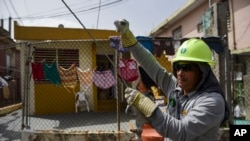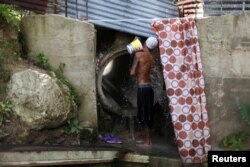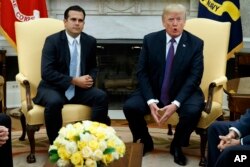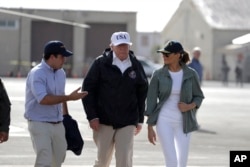“We’re continuing to go as fast as we possibly can,” U.S. Army Corps of Engineers Commander Lieutenant General Todd Semonite said Friday, briefing journalists on the state of the recovery in Puerto Rico and the U.S. Virgin Islands, which were devastated a month ago by Hurricane Maria.
News reports evaluating the islands exactly a month after the storm hit Sept. 20 say most of the communities on the islands are still without power, and many people are still living in shelters.
Officials in Washington say the fact that the affected communities are on islands, rather than on the U.S. mainland, like the areas affected by Hurricane Harvey in Texas and Hurricane Irma in Florida, is complicating efforts.
“It is very, very hard to just drive hundreds of pole trucks ... down into the Virgin Islands and down into Puerto Rico, Semonite said in Friday’s briefing.
No. 1 task: Restoring power
Semonite said the first task is to get temporary generators in place for people who are still without power, which some reports say is as much as 80 percent of the people affected by the storm. After that, he said, emergency workers must generate more power. He said Puerto Rico is operating on about 21 percent of the power it needs to supply the island.
Semonite said the task is complicated by the fact that a power plant in the capital, San Juan, declared bankruptcy and shut down in July. He said power wouldn’t be back at 100 percent until that plant is functioning again.
But even though emergency workers are working hard, Semonite said, people living in remote areas will need to live on generated power for a long time, perhaps as long as a year, before the power grid is fully capable of supplying their communities again.
“Every single thing we could possibly do,” including the federal government, FEMA and the Department of Defense, is to try “to shorten those timelines,” he said.
Also Friday, the head of the U.S. Food and Drug Administration said the agency is working with the pharmaceutical and medical supply companies that operate in Puerto Rico in hopes of avoiding shortages of needed medications on the mainland.
Reuters news service reports there are more than 50 plants that make medical devices in Puerto Rico, and they employ about 18,000 people.
Meeting with Trump
On Thursday in an extended Oval Office meeting, Puerto Rico’s governor pleaded with President Donald Trump for equal treatment for the hurricane-devastated island, repeatedly reminding him that Puerto Ricans are U.S. citizens.
“Give the U.S. citizens of Puerto Rico the adequate resources, treat us the same as citizens in Texas, in Florida and elsewhere, we will come out of this stronger,” Governor Ricardo Rossello said.
Trump again defended the federal government’s response to the devastation left a month ago by Hurricane Maria.
The president declared the response in Puerto Rico by the U.S. government a “10” on a scale of one to 10.
“We have provided so much, so fast,” he said.
The governor of the U.S. commonwealth (territory), declined to put a grade on the response, but did say “we’re thankful to the president for supporting these petitions to Congress” and promising “no U.S. citizen will be left behind.”
At one point, with a group of reporters still in the Oval Office, Trump turned to Rossello and asked: “Did we do a great job?”
The governor answered, “You responded immediately.”
In addition to electricity shortages, about 35 percent of Puerto Ricans are still without drinking water on the Caribbean island, about 1,600 kilometers southeast of the U.S. mainland.
Debt burden
The president says Puerto Rico’s debt totals $120 billion and he is considering both loans and grants to the commonwealth, but repayment of federal loans will have to come before repayment of some private debt.
The island is also grappling with reports that some local workers have not been distributing relief supplies, including food.
“There has been corruption on the island and we can’t have that,” Trump said alongside Rosello. “I think the governor will do something about that.”
Rossello responded that the National Guard is now assisting with logistics to ensure delivery and auditors are policing accountability and the Department of Justice of Puerto Rico is looking into the alleged involvement of local officials in aid distribution irregularities.
The national government’s effort in assisting residents in several southern states on the mainland recover from other hurricanes has generally won favorable reviews, but its performance in Puerto Rico has been more problematic.
Rossello, who said in the Oval Office on Thursday that “this is not over by a long shot,” has been largely supportive of the U.S. government’s recovery effort.
Rossello is the 38-year-old son of a former governor and is a member of the New Progressive Party, which advocates statehood for Puerto Rico.
Criticizes federal response
Mayor Carmen Yulín Cruz Soto of San Juan, the territory’s capital and its biggest city, has, however, frequently criticized that assertion.
Cruz Soto of the Popular Democratic Party, which advocates maintaining the island’s status as a self-governed unincorporated U.S. territory, is expected to run for governor in 2020. She has termed federal government excuses for not delivering aid quicker ridiculous, offensive and unthinkable.
Trump earlier had voiced mixed sentiments about helping the island recover, saying the national government would assist it as long as needed.
Trump on Thursday again emphasized that surge force of the Federal Emergency Management Agency (FEMA) and the 18,000 members of the U.S. military dispatched will eventually depart.
“At some point FEMA has to leave, first responders have to leave,” said Trump, explaining this is true after any disaster.
The president visited the island earlier this month to assess recovery efforts, at one point tossing rolls of paper towels into a crowd of islanders.











